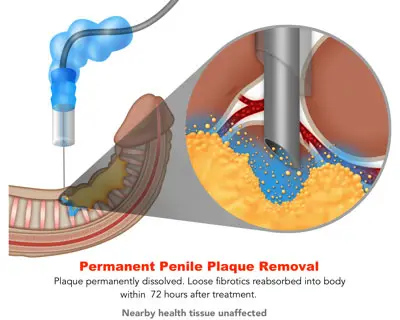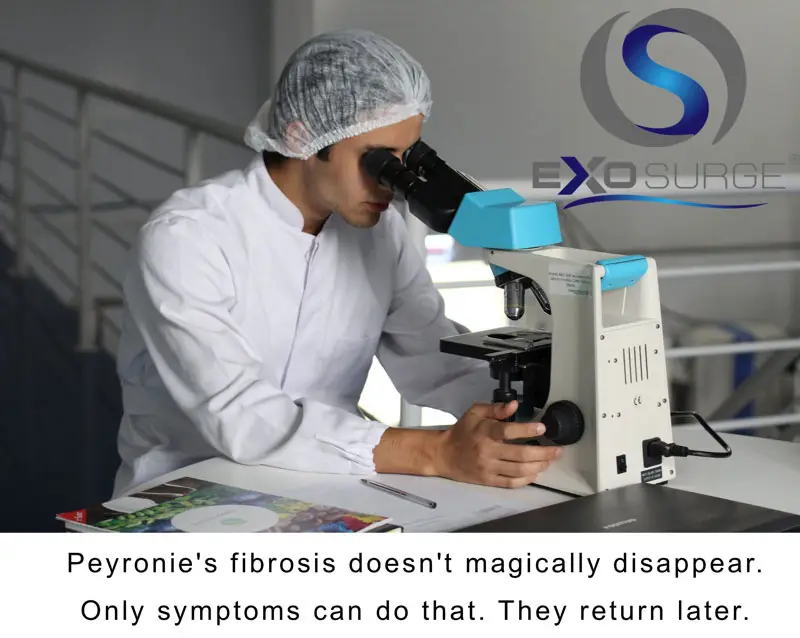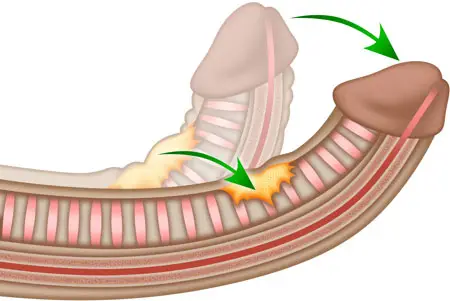Peyronie's Disease Exercises
Peyronie’s Disease Exercises for Correcting Penile Curvature
Can exercises help with reversing Peyronie’s Disease?
Exercises are not able to remove the plaque build-up inside the penis and only work in conjunction with effective medical treatments. The combination of exercises at home along with a treatment such as ExoSurge® is clinically proven to reduce penile curvature.

Peyronie’s Exercises that Work
Men often seek ways to straighten penile curvature naturally.
ExoSurge® Peyronie’s exercises are a protocol developed for men to prevent their condition from worsening “in the meantime” until the curative treatment option becomes available in their area.
The doctors at Morganstern Health invented a breakthrough technology that’s now clinically-proven to cure Peyronie’s disease.
We understand that the majority of men cannot afford to cover costs out of pocket for resolving their case and traveling to Atlanta for treatment.
Unfortunately, we’re presently unable to share many essential details of our technology and the epidemiology of Peyronie’s because they’re all tied to imminent or pending patent applications. Only through the value of our intellectual property can we afford to finance the costs associated with obtaining FDA approval and comprehensive insurance reimbursement for our innovation.
We have been informed that these regulatory obstacles could cost between $30 and $40 million. Without well-designed intellectual property to attract a suitable large pharmaceutical partner, this innovation will only end up available to cure affluent patients who can afford to pay for their own care.
Our mission is to offer insured local care to every Peyronie’s Disease patient in the world.
Peyronie’s Disease is a Progressive Disorder
The first thing you must understand about Peyronie’s disease is that it is progressive. That means the condition worsens over time. Contrary to conventional belief, it never “heals itself.” Rather, approximately 10% of men can sustain an acute penile injury, develop a curve or another visible outcome, and have those symptoms disappear. Unfortunately, our research has revealed that these symptoms will reappear later in life.
How Penile Fibrosis Occurs
Let’s start with the basics. The human body only has one primary objective, 24 hours a day, seven days a week. That is to keep us alive. It is very difficult to kill a human, as our body excels at this task.
In layman’s terms, when the body sustains an injury, it activates a variety of protective mechanisms. When we sprain our ankle, fluid forms a protective barrier around the injured tissue. If we cut ourselves shaving this morning, collagen will be sent to the wound to promote healing.
Activated fibrosis is one of our most important self-defense mechanisms; it’s like sending sandbags to that area of the body to help repair the damage. This typically only occurs in the event of a severe injury, such as being stabbed or shot. When the trauma has passed and the body no longer perceives a threat, the body sends enzymes to the area where fibrosis was activated during REM sleep to dissolve the fibrotic tissue and return it to its reservoirs.
Why Fibrosis is Such a Problem for the Penis
The penis is a human organ, whereas the female breast is a perspiration gland. The body recognizes that organs are necessary for existence. Consequently, when it detects damage to one of our organs, fibrosis is rapidly triggered. Even minor penile injury can induce a fibrotic response. Childhood examples include missed ground balls, your foot slipping off the pedal of your bike and our midsection landing on the sissy bar or grinding for hours against our first sweetheart’s pelvic bone. A fibrotic injury response can be triggered by masturbation, but only after repeated sessions. These types of injuries are referred to as “penile microtraumas.” They don’t result in a huge amount of fibrosis being sent to help protect the penis, but fibrosis is triggered.
Unfortunately, because the penis is located on the body’s periphery, it does not receive the same level of blood flow required for the body’s natural restorative processes outside of erections. However, more significant is the organ’s sponge-like structure. It confines the fibrosis within its structure, similar to a spider web.
How Peyronie’s Disease Progresses within the Penis
As indicated previously, fibrosis triggered by the body’s self-defense and healing system is expected to be degraded and returned to storage by enzymes after an injury has healed. Given that the penis is a peripheral organ with a sponge-like structure, fibrosis becomes entangled in its web.
The body detects that the fibrosis is still present in the penis and incorrectly concludes that harm is still occurring, causing it to send even more fibrosis. These subsequent fibrotic responses are not always located precisely at the site of the initial lesion, causing the formation of a larger mass.
When a man is young and in excellent health, his body is well-equipped to combat the negative impacts of these minor fibrotic deposits in the penis. As he ages or develops certain health problems, his body is no longer able to combat the effects of the fibrotic aggregates, and the symptomatology manifests or worsens. This is one reason why “problem Peyronie’s” occurs most frequently in men over 50 years old.

Side Effects of Peyronie’s Disease
Numerous adverse effects of having a noncancerous fibrotic mass become most apparent when the organ is swollen with blood during an erection. There is a limited quantity of space within the penis. When an abnormal substance is present within the tissue, something must give.

It’s a matter of displacement; do you recall the Roman mathematician who calculated the exact amount of water mass lost from his bathtub during a bath as his body became submerged? The same principle applies. Reduced erect length, indentation of the shaft, and erect curvature are some of the results. It can also cause erectile dysfunction if the fibrotic tissue obstructs the natural absorption of blood to form an erection.
How Disease Symptoms Become the Definition of a Disease
When a disease remains incurable for centuries, its symptoms almost always become society’s definition of that disease.
Similarly, the efficacy of the treatments employed to treat the disease is measured by how well they alleviate its symptoms.
For example, this phenomenon is exemplified by the common cold. Coughing, sneezing, and congestion some of the most common symptoms of a cold, and people frequently assume we have a cold if we display these symptoms. Nobody inquiries about the type of virus we are fighting, such as rhinovirus, coronavirus, adenovirus, or enterovirus.
Since Peyronie’s Disease has remained similarly incurable for about 600 years, it has likewise become only known for its symptoms, even among many physicians, with erect curvature being the most notable definition.
I’ve seen the TV ads, Is Peyronie’s defined as curvature when erect?
No, erect curvature is only a potential symptom of Peyronie’s.
Typically, fibrosis accumulates along the tunica albuginea, which is the sheath separating the two major sponges that contribute to erection formation. This explains why erection curvature is the most prevalent symptom of Peyronie’s disease (about 65% of cases exhibit this adverse effect).
If fibrous plaques accumulate on the left side of the tunica, this will cause leftward erect curvature. If the plaques were positioned on the right, the penis would curve to the right.
However, erect curvature is not the definition of Peyronie’s disease; it is merely one of the potential symptoms, albeit the most common and one that occurs in the vast majority of cases.
Can’t a surgeon Just Remove the Peyronie’s Fibrosis from my Penis?
Unfortunately, no. Since the plaques accumulate directly upon and even within the penis organ, any attempts to surgically remove it would result in damage to the neurovascular bundle that triggers erections and penile sensations.
If Peyronie’s isn’t a curve during erection, what is it?
Peyronie’s Disease (PD) is an acquired inflammatory condition characterized by the buildup of fibrous tissue plaques within the soft tissue of the penis and/or thickening of the tunica albuginea. In more rare instances, it’s triggered by a wound healing disorder.
Our research discovered that thickening of the tunica albiquea is very common with well-established Peyronies cases. Thickening can be defined both in terms of increased size from a form of swelling plus more pronounced tunica density.
Importantly, the plaques, fibrosis, and scar tissue that cause all Peyronie’s symptoms can be precisely measured. Improvement can also be precisely quantified.
This is what makes ExoSurge completely different from anything ever used to treat Peyronie’s. ExoSurge technology treats, heals and cures the underlying disease of Peyronie’s, not just its symptoms.

What sort of Peyronie’s exercises should I do while I’m waiting for my local urologist to get access to ExoSurge?
The goal of our Peyronie’s exercise regimen is to help in keeping the case from getting worse. We call it the TIVS Peyronie’s exercise regimen and we’ve found that most patients who follow this protocol don’t get noticeably worse over time.
None of these exercises break up the Peyronie’s plaque or fibrosis that triggers all the debilitating symptoms. ExoSurge is the only technology that can accomplish that.
What is the “TIVS” Peyronie’s exercise regimen?
TIVS is an acronym for Traction therapy, Improved heath, Vacuum erection devices and Steer clear of the scams.
Traction Therapy Peyronie’s Exercises
Penile traction has been proposed and utilized as a treatment for PD in order to reduce erect curvature, prevent the progression of scar
[1] L. A. Levine, M. Newell, and F. L. Taylor, “Penile traction therapy for treatment of peyronie’s disease: a single-center pilot study,” Journal of Sexual Medicine, vol. 5, no. 6, pp. 1468–1473, 2008
formation, restore sexual function, and assist in regaining lost penile length and girth.
During the phase of testing, various deformities have shown measurable improvement, according to studies2. Our research indicates that none of the treatments reduce penile plaques. However, they are an excellent instrument for temporarily combating negative symptoms.
We now prescribe penile traction as part of ExoSurge® therapeutics3, but for distinct reasons than the majority of Peyronie’s traction therapeutic experts or modalities. We recognize the potential beneficial side effects of traction following the removal of penile fibrosis, such as an increase in penile length and a decrease in penile deformities. However, the primary purpose of off-site traction therapy is to increase vascular flow. We found that PD fibrosis constricts adjacent tissue and blood flow in a manner similar to how spinal damage traps natural therapeutic fluids. Spinal traction facilitates the circulation of natural healing nutrients by decompressing the spinal injury4. Penile traction is utilized for comparable reasons as PD.
Because the Restorex® penile traction device is designed to be adjustable against erect curvature, we became particularly enamored of it. We believe that tension is particularly beneficial as the underlying cause is eliminated by ExoSurge® therapies.
[2] Yafi F A, Pinsky MR, Stewart C, et al. The Effect of Duration of Penile Traction Therapy in Patients Undergoing Intralesional Injection Therapy for Peyronie’s Disease. J Urol. 2015
[3] Ziegelmann M, et al. Outcomes of ba novel penile traction device in men with Peyronie’s disease: A randomized, single-blind, controlled trial The Journal of Urology. 2019;202:599.
[4] Park WM, Kim K, Kim YH. Biomechanical analysis of two-step traction therapy in the lumbar spine. Man Ther. 2014;19(6):527–33.
Please be aware of the minimum flaccid penile length before purchasing a Restorex is 3.75 inches if you are contemplating acquiring one. If your flaccid length is shorter than the minimum required, you should begin extending with a Zen Hanger.
Improved Health and Exercise for Peyronie's Disease
Our research revealed that your general health plays a much larger role than previously understood in the negative side effects of Peyronie’s.
We strongly recommend that you begin a regular exercise program by walking daily or spending time in a gym, and if your diet is inadequate, seek assistance in improving it.
In addition, we strongly advise you to schedule a comprehensive physical exam with your primary care physician, including comprehensive blood work. Take note of any macronutrient levels that are deficient, no matter how slight, and ask your doctor for supplement recommendations to optimize these metrics. An L Arginine5 L Citrulline Supplement with Nitric Oxide will benefit nearly every patient with Peyronie’s disease. The additional stimulation of blood flow is therapeutic for combating the symptoms of Peyronie’s disease.
Use of PDE-5 Inhibitors
We also advise you to request a prescription for PDE-5 inhibitors from your physician. PDE-5s are known to aid in the treatment of Peyronie’s disease6 by elevating cyclic guanosine monophosphate in the corpora and increasing penile blood flow.
[5] Valente EG, Vernet D, Ferrini MG, et al. L-arginine and phosphodiesterase (PDE) inhibitors counteract fibrosis in the Peyronie’s fibrotic plaque and related fibroblast cultures. Nitric Oxide 2003;9:229-44.
[6] Ziegelmann M, et al. Outcomes of ba novel penile traction device in men with Peyronie’s disease: A randomized, single-blind, controlled trial The Journal of Urology. 2019;202:599
Vacuum Erection Device (VED) Exercises
Vacuum erection devices (VED) were the first successful physiological treatment for erectile dysfunction and have a lengthy history of use in the treatment of erectile dysfunction and Peyronie’s disease7. VEDs have been discovered to be only marginally efficacious when used alone to treat PD8.
The daily off-site use of a VED during ExoSurge® therapeutics has been found to be advantageous for supporting increased blood flow9 as plaque is removed during ExoSurge therapy. Daily use of a VED supports penile health, which declines with age in the absence of such interventions. The manual stimulation of penile blood flow supports this effort to prevent the formation of additional lesions and fibrosis.
We believe that the combination of penile traction and VED therapy is an ideal combination for preventing the progression of Peyronie’s disease-related side effects.
Steer Clear of Peyronie’s Disease Scams
Every man fantasizes about discovering a straightforward, miraculous treatment for Peyronie’s Disease. Please keep in mind that this disease has existed for over 600 years and that the only therapies proven to treat symptoms have a rather lackluster track record.
[7] Valente EG, Vernet D, Ferrini MG, et al. L-arginine and phosphodiesterase (PDE) inhibitors counteract fibrosis in the Peyronie’s fibrotic plaque and related fibroblast cultures. Nitric Oxide 2003;9:229-44.
[8] Ziegelmann M, et al. Outcomes of ba novel penile traction device in men with Peyronie’s disease: A randomized, single-blind, controlled trial The Journal of Urology. 2019;202:599
[9] Ziegelmann M, et al. Outcomes of ba novel penile traction device in men with Peyronie’s disease: A randomized, single-blind, controlled trial The Journal of Urology. 2019;202:599
No ancient or modern supplement will ever cure Peyronie’s disease. It is a very complex disease that must be treated in concert with comprehensive patient health dynamics.
There is now conclusive evidence that PRP injections have zero positive effect on Peyronie’s disease. Any new version the doctor concocts that differs from those that failed will have no effect on the outcomes. The failure is a direct result of nocturnal erections occurring during REM sleep. Within 48 hours, 99.9% of injected cells are eliminated from the penis.
Plaque removal is unaffected by the utilization of any type of shockwave therapy for Peyronie’s disease. Importing our first unit directly from Romania, we were the first urologists in the United States to offer shockwave therapy to treat erectile dysfunction. Theoretically, shockwave treatments should enhance Peyronie’s disease, but extensive research comparing baseline and follow-up plaque sizes revealed that they have no effect on reversing the disease.
Combining shockwave therapy and P-shots will only increase the rate at which your money is wasted.
We understand how tempting it is to try these simple sounding solutions.
None work. Please save yourself the time and money you’ll lose.

